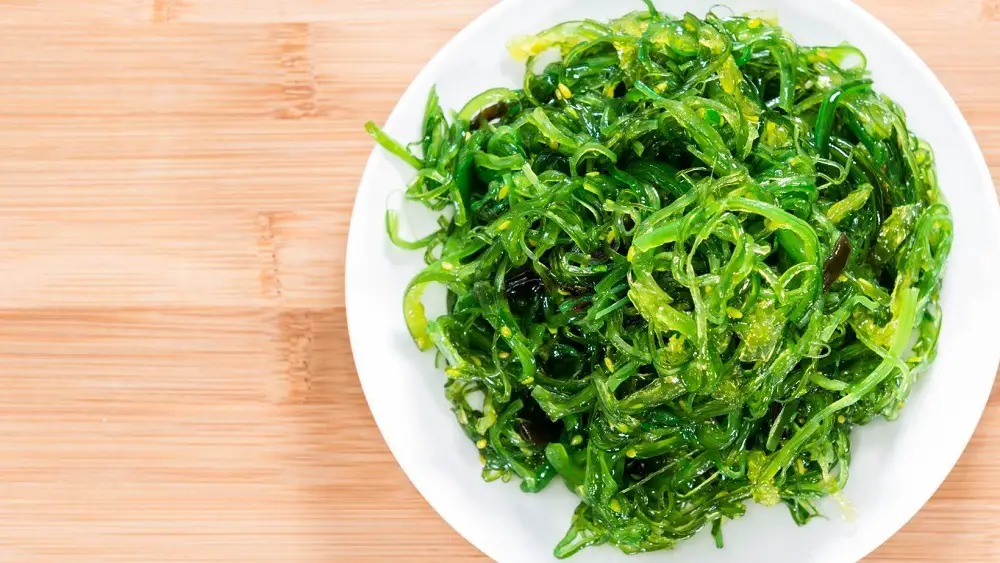Kelp noodles are clear, fine noodles that are made from kelp. This is a type of brown seaweed known for its high iodine content. Many people are deficient in iodine as it is only really found in seafood. It is estimated that up to ⅓ of people suffer from an iodine deficiency which can leave you susceptible to a host of health issues.
Kelp noodles are also known as seaweed noodles or popping seaweed. They are not similar in flavor or texture to regular pasta. They are visually similar to regular noodles and can be cooked and prepared in a similar manner. They are generally considered to be a raw food, although raw food purists may not always agree.

It may surprise you to know that the kelp used to make the noodles is brown or green, given that the kelp noodles are clear. This happens as the kelp has the skin removed. This is then desiccated and transformed into a powder. This powder is then combined with another form of seaweed, sodium alginate, and water. This mixture is then formed into long noodle strands.
They are commonly found in health food stores, although they are sneaking their way into general grocery stores. Kelp noodles do not have a strong flavor. If you do not cook them fully then they can be a little crunchy, and if you do not rinse them well they can be relatively salty.
How do you prepare kelp noodles?
Kelp noodles are purchased in a pouch or bag, surrounded by salty brine to keep them fresh. You will need to cut the pouch open and drain off this packaging liquid. You should then rinse them well – an easy way to do this is by placing them in a sieve under a tap of running water.
Some people prefer to soak their kelp noodles in a large bowl of warm water for 10 minutes. This will allow all of the residual salt to dissipate out into the water to be removed. It will also help to soften the kelp noodles slightly and separate them from one another. Drain once more.
We recommend chopping or cutting the kelp noodles. When purchased, they are incredibly long strands that can be difficult to portion out and eat.
Kelp noodles can be consumed raw or cooked. If you are going to be eating the noodles raw, we recommend allowing them to sit in a marinade for a few hours before serving. This will give the noodles time to absorb some of the dressing flavors for a more fulfilling meal.
If you would prefer to consume the kelp noodles cooked, we advise throwing them into a stir fry. Cook the proteins and vegetables as you usually would and add in the sauce. About 30 seconds before serving, add the noodles to the pan and allow them to warm through.
What should you serve with kelp noodles?
As the summer months and warm weather come ever closer, we are partial to a kelp noodle salad. Finely shred some greens of your choice, such as kale and iceberg lettuce. Add in some fermented vegetables, such as sauerkraut. This will give the salad a salty kick and your gut microbiome will thank you! For an even bigger nutrient hit, create your own fermented vegetable mix with all of your favorite produce.
Top this salad with some avocado and a generous squeeze of lemon or lime juice. Massage this into your noodles, using your hands to ensure everything is properly combined. We recommend adding in a protein source such as cubed tofu for a more satiating meal.
Kelp noodles nutrition
Kelp noodles are very low in calories, making them a favorite in weight loss circles. This is by no means the only benefit they have going for them. The Japanese diet is believed to consist of around 21% seaweed (giant kelp, bongo kelp, and kombu). This is suggested as a reason for their long life span.
There is a natural fiber found in kelp known as alginate. This is believed to act as a fat blocker in the body, preventing the gut from absorbing fats. This is another reason that the weight loss culture loves these noodles.
As we have mentioned, kelp noodles contain a high portion of iodine too. This is one of the best natural sources of iodine, which is crucial for the production of thyroid hormones. These are used to balance your metabolism and help to support healthy pregnancies.
If you are suffering from an iodine deficiency it can lead to the development of a number of other diseases. These include PCOS, prostate issues, thyroid conditions, autoimmune diseases, and diabetes. The National Institute of Health recommends a daily intake of 150 mcg for adults.
Kelp is high in a number of vitamins and minerals including Vitamins K and A, calcium, iron, and magnesium.
Kelp also contains a lot of antioxidants. These are compounds that counteract the negative effects of free radicals on the cells of your body. Free radicals have been linked to the development of cancer, therefore kelp noodles can help to protect you against this. They have been shown as particularly effective against breast and colon cancers. The antioxidants in kelp have also been shown to assist in managing the treatment of diabetes and as an anti-inflammatory agent.
Are there any dangers to kelp noodles?
If you consume too much iodine, this can cause health issues. Consistently excessive iodine intake can lead to the inflammation of your thyroid gland. In severe cases, this can even lead to the development of thyroid cancer. It can also cause fevers, nausea, diarrhea, stomach aches, a weakened pulse, and even death.
Kelp noodles are also very low in fiber. This means that if you substitute them for whole-grain pasta or rice, your fiber intake will drop considerably. This can lead to issues with digestion and can contribute to the development of diabetes and heart disease.
